In this guide:
- What are agency utilisation rates?
- How to calculate agency utilisation rates
- What is a good employee utilisation rate?
- Utilisation rate benchmarks
- Using utilisation rates to forecast your capacity and revenue
- Tracking utilisation rates
- How agencies can improve utilisation
- Ready to boost your agency’s utilisation rates?
Getting to grips with your agency’s utilisation rate can be truly transformational to your agency's planning and profits.
Often deemed one of the key measures of an agency’s success, if you’re an agency owner or manager you’ll be all too familiar with the term “utilisation rates”. But what exactly are they, and why are they so important?
What are agency utilisation rates?
Utilisation rates show how much time staff are spending on chargeable client work versus work that isn’t directly bringing in any income.
It’s a measure of the percentage of someone’s working hours that are made up of billable work. For example, writing social media posts for a client would be billable work, sitting in a meeting about how the agency is planning to attract new clients isn’t.
At best, the most you can expect is seven hours billable time in a seven and a half hour working day, but for many staff the figure will be much lower than this.
As well as internal meetings, business building, personal development and general admin tasks, your non-chargeable time also needs to take into account loo breaks, tea breaks and lunch times
Understanding how much chargeable time each person in your agency can achieve each week enables you to work out how much capacity you have and how much revenue you could realistically bill.
And, because understanding employee utilisation requires accurate time-tracking, it brings with it a raft of benefits and opportunities, which we'll go into below.
How to calculate agency utilisation rates
The basic utilisation rate formula is pretty straightforward: chargeable time divided by available time.
'Chargeable time' (also known as 'billable time') is the time utilised on client work that could be charged for. It can become a bit more complex, as chargeable time is not always billed or 'recovered'. But that's another matter! It's important that employees track all their time on client work regardless of whether it's within budget to calculate utilisation rates accurately.
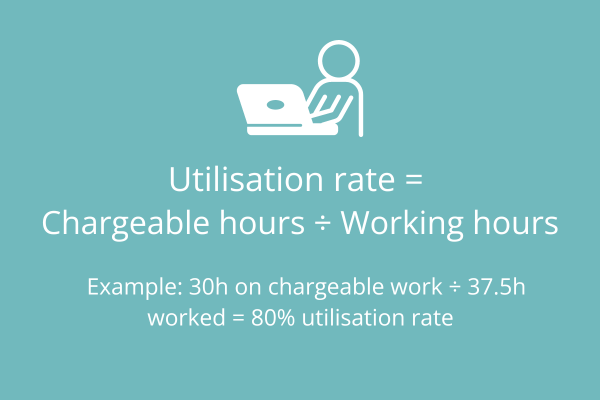
Utilisation rates vary by role and responsibilities - there’s no one-size-fits-all - so you’ll need to look at each person within your agency on an individual basis.
To calculate your team's target utilisation rates, Agency management experts Agency Works recommend the following process:
- Interview each team member. Ask them how much time they spend on non-billable work. This will vary from person to person, and it’s not set in stone. But you might find some team members are more frequently put on internal jobs, for example, than others.
- Take a look back at their timesheets over the past year. This will give you an accurate picture of time spent (if timesheets have been logged correctly). If you just do a month or two, you could catch someone in the holiday season or when they’ve been temporarily working on an internal project. The broader the timeframe, the better.
- Consider your plans for the year. Have you got any major internal projects coming up or new business initiatives that will divert certain people’s time? This goes back to the ‘individual’ aspect. Which of your team are you likely to use most for non-client work?
- Calculate their target chargeable hours (aka target utilisation). Deduct their non-billable hours from their total hours to give you your number of chargeable hours (you can turn this into a percentage).
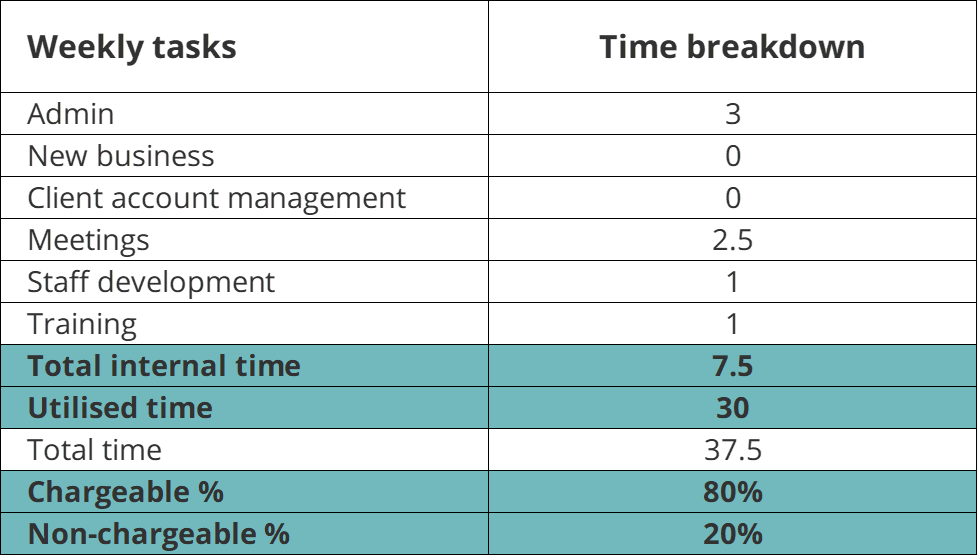
Read more: Understanding your agency’s profit levers: utilisation rates (theagencyworks.co.uk)
What is a good employee utilisation rate?
It’s important to remember that utilisation rates are not a measure of how hard someone is working. Higher is not necessarily better.
Often, the most senior staff in an agency will have the lowest utilisation rates due to their raft of management responsibilities. The bulk of their work will usually be more internally focused.
In fact, in a 2023 survey of 614 agencies, accountancy firm The WOW Company found the directors of the most profitable and fastest-growing agencies had lower utilisation rates than average. This allowed them to work more ON their business, rather than IN it, which in turn boosted growth.
And, remember, an individual’s utilisation rate will fluctuate too.
An individual’s utilisation rate could change over the course of a year or month, depending on what they’re working on. For example, a one-off project such as revamping your website might require your designers to spend a proportion of their time working on that rather than for clients.
The only people you can expect to have a 100% utilisation rate are freelancers, who you only pay for their output.
And if an agency’s overall rate is close to 100% it can be a warning sign. Whilst it might initially sound efficient, it could mean you are overworking your team and failing to spend enough time on the activities that could help you grow.
Utilisation rate benchmarks
While higher isn’t always better, it is useful to have an idea of agency utilisation rate benchmarks or averages.
According to The Wow Company Benchpress report, the industry average agency utilisation rate is around 65%.
However, utilisation rates vary widely across different roles. Rising to 75% for junior staff and dropping to 33% for director-level staff.
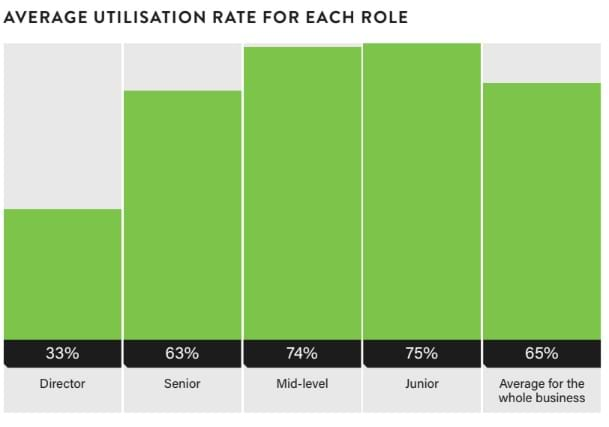
Source: Wow company, Benchpress 2023 report - Profit and Growth for £1m+ agencies
Unsurprisingly, they found that agencies who use agency management software had an average 'non-director' rate of 75%. That's a big difference. Imagine you have a team of 10 designers, charged at £100ph, each with a utilisation rate of 65%. Multiplied by the number of hours they work — they could generate £1,131k of revenue per year. Now, increase their utilisation rate to 75% — they could generate £1,305k per year — that’s an extra £174k!
The same report also found Synergist is the most popular software used by £1m+ agencies.
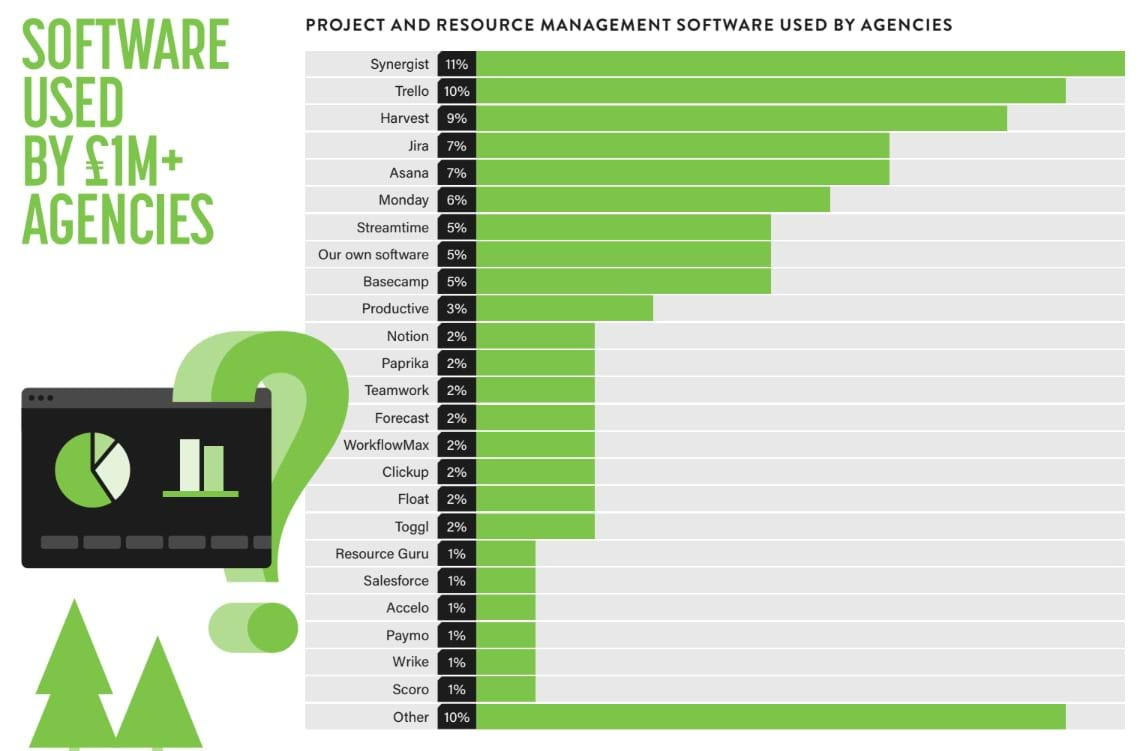
Source: Wow company, Benchpress 2023 report - Profit and Growth for £1m+ agencies
Utilisation rates will vary widely across different agencies, depending on a variety of factors - not just efficiency.
Comparisons between your own rates and those of competitors can be unhelpful, even if you’re comparing those doing similar roles. A midweight designer in one agency is not necessarily equitable with their counterpart in another agency - so it’s not a case of utilisation by role, but by person.
As anyone working in agencies will know, they come in all shapes and sizes, with vastly different cultures. Some places have a very relaxed culture, with teams chatting over breakfast or Friday afternoon drinks. Based solely on utilisation rates, this could look really inefficient, but if it’s fostering a culture where people feel motivated to do their best work and to remain loyal to the company, it’s surely worth the dip in productivity?
Fundamentally, changing your agency's culture purely to up your utilisation rates is the fastest way to wave goodbye to your talent.
Using utilisation rates to forecast your capacity and revenue
Once you’ve calculated realistic utilisation rates for everyone in your agency, you know how much time you actually have available to sell, and you can calculate your agency's achievable revenue.
Using the formula below, you can calculate the capacity and revenue per person, team, and agency overall.
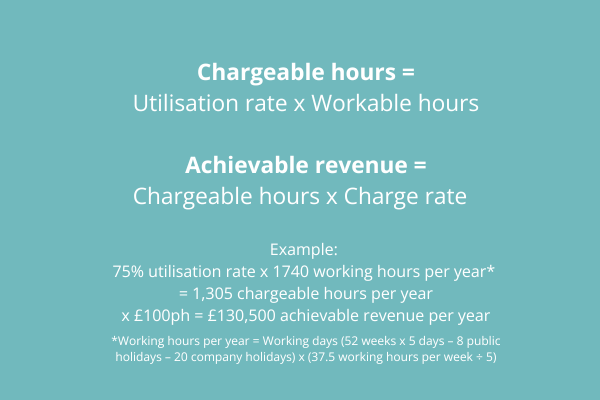
To make this figure recoverable, you need to make sure you’re selling all the hours. Otherwise, each designer might be working at 75% utilisation on client work, but you might not be getting paid for it.
Ask yourself: does your proposition enable you to sell those hours, week in week out?
Getting to grips with your utilisation rates makes it far easier to manage your capacity - making sure you’re selling the right work and you've got the right people.
Tracking utilisation rates
Accurately tracking utilisation can be a game-changer for your agency, bringing with it a host of benefits.
Monitoring how much time has been spent on chargeable and non-chargeable work vs target utilisation rates lets you instantly see if your team's time is used as planned. For example, a creative could be spending an hour a week on client update calls. Spotting things like this can help you take steps to save that time.
But let’s face it, if you’re working in a creative agency, filling out timesheets is probably not your thing.
It can initially be difficult to get staff to buy into the importance of accurate utilisation rates and the need for time-tracking that goes along with this.
What’s important is communicating why you're tracking time and explaining the personal benefits to them.
Making it easy for them to do this is also key. Time-tracking as you go using a platform with built-in job information and stopwatch/timer options like Synergist timesheets means no more struggling to remember at the end of the week and no more guesstimates. And easy-to-understand reports help you see what’s really going on inside your agency.
Keeping track of how time is spent is one of the most valuable reporting tactics you can employ. You can look at how well-utilised and billable your people are, which ultimately translates into how profitable they are.
"If I spot something interesting, I can drill into it using Synergist. For example, if a department's underutilised, is it because we're not bringing in the right type of work? Or we're not quoting or billing enough for the work they're doing? Understanding this is the key that can unlock the success or otherwise of the business."
How agencies can improve utilisation
Ideal utilisation rates will look different for all agencies and the individual teams within them. What’s important is that once you get an accurate handle on your current utilisation rate, you have a benchmark upon which to improve and a way of measuring any changes' success.
So, how do you go about improving your utilisation rate?
Here are 7 key things you can do to improve your utilisation rates and chargeable time:
- Track time accurately. Make sure people log all their time to the job - not just scheduled time - so you can accurately track where you’re overrunning on client work vs. where time is spent on internal stuff. You can’t fix it, if you don’t know it’s happening!
- Sell the right hours. You don’t want one team overloaded with work, while another team is twiddling their thumbs. The ideal scenario is that all team members are working on chargeable work all the time. To move as close to this scenario as possible, you need a clear view of what’s booked against each department. From there, you can look at where there are gaps, and your sales or client team can look to fill these gaps in capacity.
- Avoid overscheduling. If people are overbooked on a job, they'll either finish early and have nothing to do or spend longer than quoted, enhancing, crafting and honing. Make sure jobs are estimated accurately and the right amount of time is booked.
- Make sure briefs are ready. People sitting around waiting to be able to start work is painful. If a job's scheduled, the brief should be ready. Storing all project information, including documents, briefs, estimates, tasks, and communications, in one place can remove bottlenecks because crucial information is hidden in someone’s inbox!
- Invest in staff development. Sometimes you have to invest time to make time. Make sure senior people are not overbooked while juniors are sitting around. Look at what can be delegated to juniors or training/shadowing needed so they can do it next time.
- Develop standard processes. Having defined ways of doing things will help you operate far more efficiently. So get templating, get automating, get streamlining.
- Cut admin and meetings. The bane of most people's life! Simplifying tasks and ditching unnecessary meetings (or making them snappy) can free up precious time for more chargeable work. And make your team happier!
Find out how ArmstongB2B marketing agency improved utilisation and productivity with Synergist
Ready to boost your agency’s utilisation rates?
Understanding utilisation rates and ensuring yours are as accurate as possible can truly transform your agency. Influencing everything from capacity planning and how you price new business to the wellbeing and retention of staff. It’s worth investing the time in getting it right.
A successful agency is one that can communicate the importance of utiilisation rates to staff and ensure they are fully brought into the idea, logging their time honestly and sharing ideas if they feel utilisation can be improved.
And agency management software like Synergist can make these conversations even easier by producing easy-to-understand reports and graphics that show exactly how and where people spend their time - enabling you to set goals that reflect the nature of your business, rather than arbitrary figures that might not suit the way your people work.
Book a demo
See why thousands of agencies - from design to digital, 10-500 people - choose Synergist to manage their operations more intelligently and profitably.
